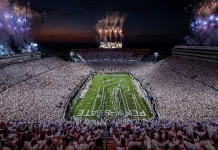Although Florida is home to many world-class golf courses, lush weather, and a massive golf culture, the Men’s U.S. Open (organized by the USGA) has never been played there. Several key factors help explain this anomaly: climate and weather challenges, course suitability and infrastructure, historical preference, and scheduling/logistics. With insight from the golf betting experts at Bet442, here are possible reasons why the state has never hosted the men’s U.S. Open.

Climate & Weather Risks
Florida has very high annual rainfall, especially in summer, plus high humidity. Maintaining firm, dry, fast playing conditions is especially difficult. The U.S. Open demands extremely challenging setups, fast greens, and firm fairways, which are harder to achieve in a hot, humid, wet environment. This makes the risk of delays, soggy turf, and inconsistency much greater.
The Atlantic hurricane season peaks during summer. That adds risk to holding a major week-long event. Even the theoretical risk of storms can dissuade the selection of a site. The U.S. Open is held in mid-June. In Florida, that’s deep in the summer, which is very hot, humid, and is often the start of heavy rain/storm periods. It’s less than ideal for both players and spectators.
Course & Agronomic Considerations
Many of Florida’s courses are built on warm-season grasses (e.g. Bermuda, Paspalum). These grasses behave differently than the cool-season grasses common in Northern/temperate zones: under heat/humidity, they can grow aggressively, need more maintenance, and may not hold the ball or green speed in a way the USGA wants for a major.
The U.S. Open often asks for firm and fast walking/dry conditions so that fairways are tight and ball roll is a factor. Florida’s soils, rainfall patterns, and underlying water tables can make that harder to sustain, especially without massive infrastructure (drainage, grading, maintenance).
Many great Florida courses are resort style or “lush”, with abundant trees, water, and views. But the U.S. Open requires more rugged and penal setups, deeper rough, steep tee heights, etc. Courses must be able to be adapted in ways that some Florida layouts may not be designed for.
Historical Choices, Tradition & Rotation
The USGA tends to favour certain historic and proven venues that have hosted before, courses in the Northeast, Midwest, California, etc. There is a kind of “canon” of classic U.S. Open courses (Pebble Beach, Oakmont, Winged Foot, Shinnecock, Baltusrol etc.). Florida has fewer courses with that long pedigree of major-championship hosting and experience under USGA U.S. Open-level stress.
Although the USGA likes to rotate the U.S. Open among different regions, Florida may be seen as offering less of the kind of varied challenge the USGA wants from year to year.
Scheduling & Logistics
Holding a tournament in Florida in mid-June puts players and especially spectators at risk of heat exhaustion, high UV, and thunderstorms. This affects attendance and TV viewership comfort. The U.S. Open requires qualifying sites across many states, infrastructure, hoteling, transport, etc. For some Florida courses, meeting those logistical demands (for attendees, media, staff) during peak summer might be more challenging or expensive.
To host a U.S. Open, a course must satisfy the USGA’s standards: for greens, drainage, spectator access, transportation, amenities, and sometimes even lodging near the site. Some Florida courses may not meet all those or may require heavy upgrades. The uncertainty of the weather also means more investment in backup plans, drainage etc., which may deter selection.







